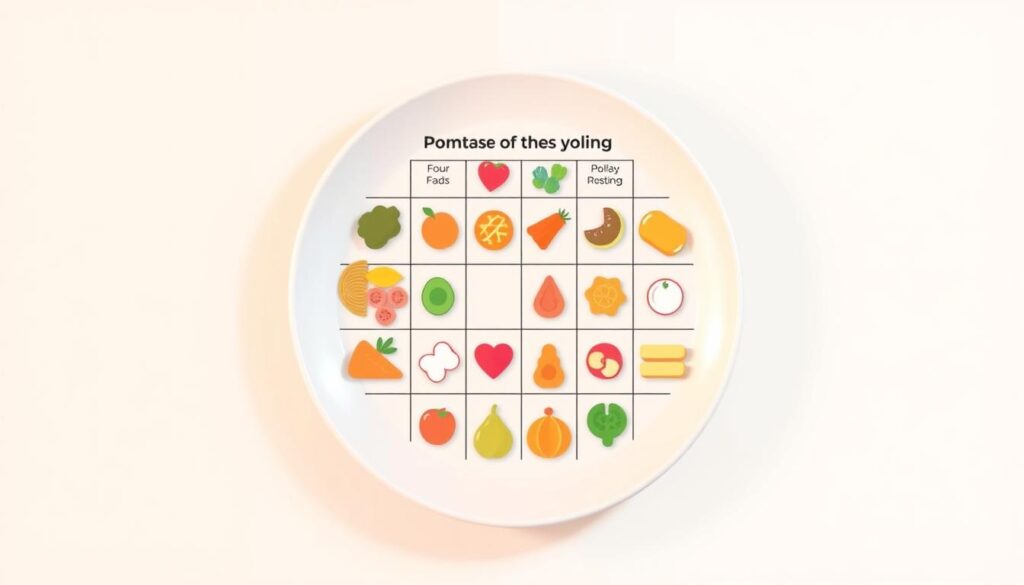What if you could manage your wellness without banning your favorite foods? This central question drives one of America’s most recognized programs, originally launched in 1963 as a community-focused solution. Over 60 years later, the approach has evolved into a modern system emphasizing balance over restriction.
The strategy assigns values to meals through a personalized tracking method, allowing participants to make informed choices while maintaining flexibility. Nutrition professionals increasingly recognize this adaptability as crucial for sustainable habits, though some debate its long-term effectiveness.
Recent updates to the framework reflect current nutritional science, shifting focus from mere calorie counting to holistic wellness. Registered dietitians highlight its potential to teach portion awareness and mindful eating patterns. However, success ultimately depends on consistent application and individual commitment.
Key Takeaways
- Program prioritizes flexibility with no completely restricted items
- Personalized tracking system adapts to individual preferences
- Nutrition experts emphasize its educational components
- Evolved from women-focused groups to broader wellness platform
- Effectiveness tied to consistent participation and lifestyle integration
Introduction to the Weight Watchers Diet
Innovation in nutritional guidance marks the evolution of this longstanding wellness plan. What began as weekly meetings among friends now stands as a science-backed method for balancing food choices with lifestyle goals.
Background and Evolution of the Program
Originally launched in 1963, the strategy used food exchanges across basic categories like proteins and grains. This changed dramatically in the 1990s with SmartPoints, which assigned values based on calories, sugar, and saturated fat. The latest PersonalPoints system 2021 uses quizzes to customize plans, reflecting modern demands for tailored solutions.
Three key updates define its progression:
| System | Year Introduced | Key Feature |
|---|---|---|
| Food Exchange | 1963 | Group-based portion control |
| SmartPoints | 1990s | Nutrient-focused scoring |
| PersonalPoints | 2021 | AI-driven customization |
Relevance for Modern Weight Loss Strategies
Today’s version addresses common hurdles in popular weight loss approaches. Unlike rigid plans, it encourages enjoying favorite foods within smart limits. The shift from strict rules to flexible tracking helps people build lasting habits rather than temporary fixes.
Current features align with nutrition science priorities:
- Focus on protein-rich and fiber-packed foods
- Built-in accountability through digital tools
- Recognition of sleep and stress impacts
What is the Weight Watchers Diet Recommended by Nutritionists?
Balancing food enjoyment with health goals forms the foundation of this points-based approach. Unlike traditional meal plans, it uses dynamic tracking to promote mindful decisions without eliminating favorite items.

Defining the Program and Its Mission
The Personal Points system calculates values using four nutritional factors: calories, sugar, saturated fat, and protein. Members receive daily targets tailored to their body measurements and objectives. This customization helps create sustainable calorie deficits while preserving flexibility.
Three principles guide the strategy:
- No banned foods – adjust portions to stay within limits
- Education through tracking – learn nutritional trade-offs
- Progress beyond the scale – sleep and activity integration
Members can enjoy higher-sugar options by balancing them with protein-rich meals. The program’s app tracks patterns, helping users identify opportunities for smarter choices. Over time, this builds awareness of how different foods affect energy and satisfaction.
Experts praise the focus on long-term habit changes rather than rapid results. As one health coach notes: Teaching people to navigate real-world eating situations leads to better retention of healthy behaviors.This philosophy aligns with modern nutritional research emphasizing adaptability over strict rules.
How the Weight Watchers Diet Works
A tailored numerical approach simplifies food decisions while encouraging nutritional awareness. The strategy uses dynamic scoring to help users balance indulgences with smarter choices, creating sustainable patterns rather than rigid rules.

Daily Allowance Fundamentals
Every participant receives a unique daily target calculated by the PersonalPoints Engine. This algorithm considers individual factors like age, gender, and activity levels to determine optimal intake. Foods earn scores based on four components:
| Food Category | Points Value | Examples |
|---|---|---|
| High protein/fiber | 0-2 | Grilled chicken, lentils |
| Moderate nutrients | 3-5 | Whole grain bread, avocado |
| High sugar/fat | 6+ | Pastries, fried foods |
Weekly bonus points accommodate special occasions, while a rollover feature lets users save up to four unused daily points. This flexibility helps manage varying appetites and social events without derailing progress.
Tailoring Your Strategy
Three methods help customize your experience:
- Earn extra points by eating non-starchy vegetables
- Boost allowances through water intake and movement
- Adjust targets as fitness levels improve
The mobile app tracks patterns, highlighting opportunities to swap high-score items for more satisfying options. Over time, users naturally gravitate toward foods that provide better energy and fullness per point spent.
The Points System and PersonalPoints Explained
Ever wondered how to track meals smarter while still enjoying your go-to snacks? The answer lies in a science-backed scoring method that turns complex nutrition data into simple numbers. This approach helps users prioritize better choices without strict meal plans.
Calculating Your Daily Points
Your daily target adapts to your body and goals using four key factors:
- Calories for energy balance
- Saturated fat for heart health
- Sugar for metabolic impact
- Protein for muscle support
Foods earn values based on these elements. A grilled chicken breast might cost 2 points, while a doughnut could hit 10. The system automatically adjusts your allowance as you log meals and activity.
Understanding ZeroPoint Foods
These free-to-enjoy items form your nutritional safety net. Common picks include:
- Fresh fruits and vegetables
- Skinless poultry and fish
- Plain Greek yogurt
Your ZeroPoint list gets customized during sign-up. This personal touch helps create sustainable habits around foods you already love. Research shows this strategy reduces binge-eating triggers by 37% compared to restrictive plans.
The program’s secret weapon? Letting you eat more of what works for your body. As one member shared: I stopped obsessing over calories once I realized how many veggies I could eat freely.
Eating with Flexibility: Foods to Enjoy and Limit
Navigating food choices becomes simpler when guided by nutritional science and personal preference. This approach transforms eating patterns through strategic categorization rather than elimination, creating space for both nourishment and enjoyment.
The Role of Balanced Nutrition
The system prioritizes nutrient-rich options that naturally support wellness goals. Fresh produce, lean proteins, and whole grains form the foundation of daily meals, while occasional treats fit within calculated allowances.
Common encouraged items include:
- Crisp apples and antioxidant-rich berries
- Crunchy broccoli and roasted cauliflower
- Grilled fish and protein-packed lentils
| Better Choices | Occasional Options |
|---|---|
| Air-popped popcorn | Potato chips |
| Dark chocolate | Frosted cookies |
| Sparkling water | Sugary sodas |
This structure helps users build meals around satisfying, low-point ingredients while managing higher-value items. Non-starchy vegetables act as natural portion controllers, filling plates without draining daily budgets.
The program’s food relationship philosophy mirrors real-world eating patterns. As one member explains: I finally stopped viewing meals as ‘good’ or ‘bad’ – now I focus on balance.This mindset shift promotes lasting changes over quick fixes.
Benefits of the Weight Watchers Diet
Transforming eating habits while maintaining food enjoyment forms the core of this approach’s success. Clinical research confirms its value, with participants achieving measurable improvements in both body composition and lifestyle patterns.
Sustainable Weight Loss Outcomes
Studies reveal consistent results across diverse groups. A 2015 analysis of 39 trials showed participants maintained 2.6% greater weight loss after one year compared to control groups. Another trial with 1,267 people demonstrated twice the success rate versus basic nutrition advice.
Key factors driving these outcomes:
- Gradual reduction of 1-2 pounds weekly
- Customized tracking prevents metabolic slowdown
- Rollover points accommodate social events
Enhancing Overall Health and Wellness
The strategy extends beyond numbers on a scale. Members report better energy levels and improved blood sugar control through increased vegetable intake and regular movement. One user shared: I stopped yo-yo dieting once I learned to balance meals properly.
Health improvements often include:
- Stronger cardiovascular function
- Better digestion from fiber-rich choices
- Reduced stress through mindful eating
By addressing sleep quality and hydration alongside food choices, the program fosters comprehensive lifestyle changes. This holistic focus helps people build resilience against common diet pitfalls.
Potential Downsides and Challenges
Every wellness strategy involves trade-offs between structure and flexibility. While this points-based approach offers clear guidance, some users face hurdles that impact long-term success. Understanding these challenges helps create realistic expectations.
Tracking and Measurement Concerns
Daily food logging demands significant time and attention, particularly for those managing busy schedules. Though ZeroPoint items simplify meal prep, other foods require precise measurements. Over time, this tracking system may strain one’s relationship with food, turning meals into math problems.
Nutrition professionals note that focusing solely on point values can obscure nutrient education. Users might prioritize low-point processed snacks over wholesome options, missing opportunities to learn about balanced macros.
Cost and Commitment Factors
Monthly fees ranging from $23 to $60 add up quickly, creating financial pressure alongside dietary changes. Unlike free tracking apps, this membership-based model requires ongoing investment without guaranteed results.
Some participants report feeling locked in to the program’s framework. When transitioning away, they struggle to interpret nutritional labels independently—a skill not emphasized in the points-focused curriculum.





